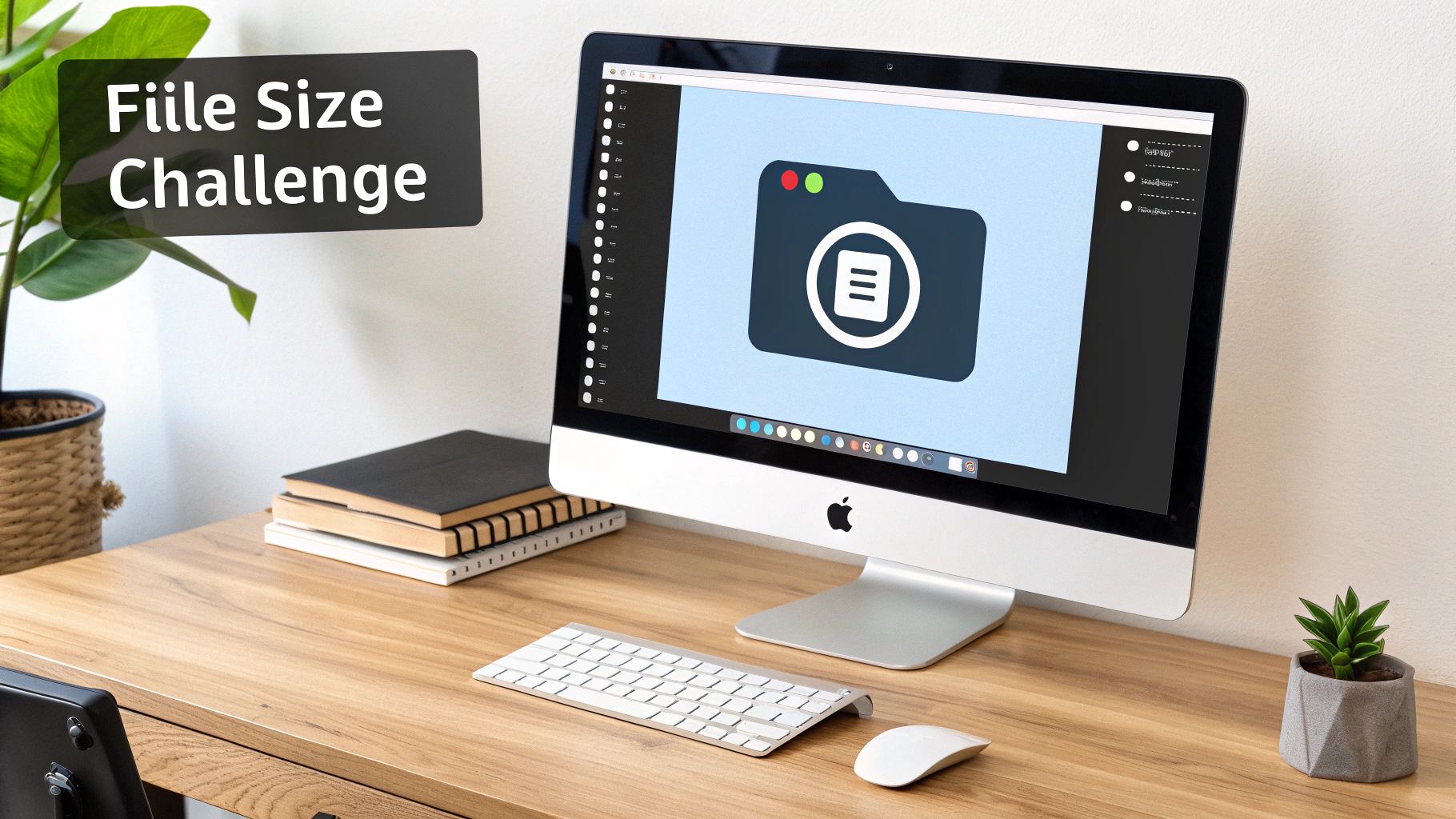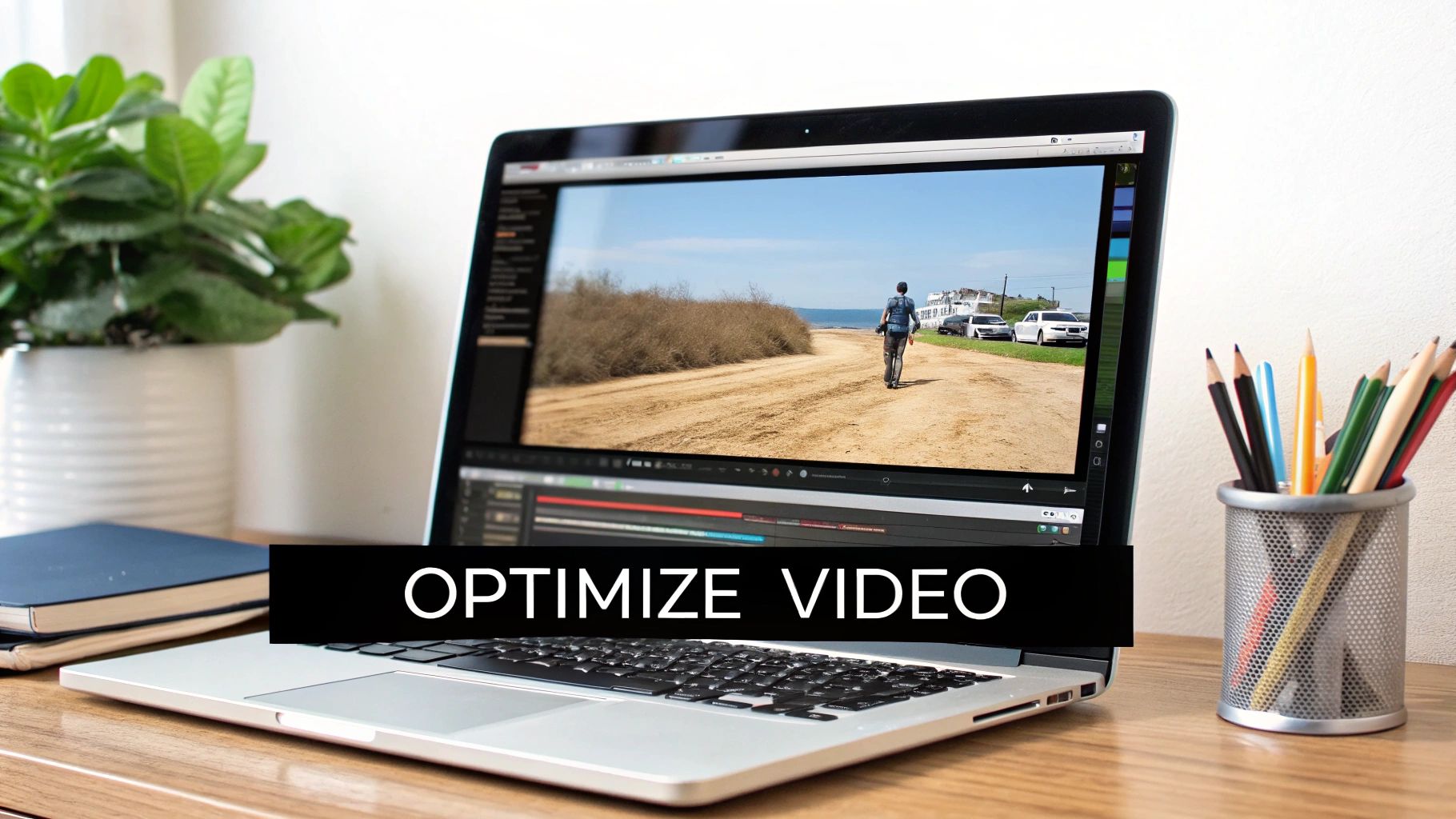How to Send Large Video Files: Fast & Secure Methods
Why Large Video Files Present Such a Challenge
Sharing videos is now a core part of how we communicate, but sending large video files can be a real roadblock. This difficulty comes from several factors, including the limits of standard transfer methods like email. Most email providers have strict size limits, often around 25MB, which makes them unsuitable for sending anything but short, low-quality videos. This forces people to look for other solutions, making sharing more complicated.
Even with fast internet, bandwidth and data transfer speeds can make uploading and downloading large videos slow. The increasing resolution of videos today adds to this problem. Moving from 1080p (Full HD) to 4K (Ultra HD) creates much larger files, and the shift towards 8K makes this even worse. Transferring large files becomes a time-consuming, and sometimes impossible, task.
This demand for higher resolution adds another layer of difficulty. The sheer size of modern high-resolution videos is a major challenge. A single hour of 8K video at 60 frames per second can take up over 6 terabytes (TB) of storage. Transferring this much data requires specialized tools and infrastructure. As resolutions increase from 4K to 8K and beyond, raw video files grow exponentially, reaching hundreds of gigabytes or terabytes each. Learn more about massive file transfers: Guinness World Record Largest File Transfer

Understanding the Impact of Video Properties
Several factors affect a video's file size:
-
Resolution: Higher resolutions (4K, 8K) mean more pixels per frame, and thus larger files. It’s like a photograph – a higher resolution image needs more data.
-
Frame Rate: Higher frame rates (60fps, 120fps) capture more images per second, increasing file size. Imagine flipping through a photo album – more photos make a thicker album.
-
Bitrate: Bitrate measures data used per second of video. Higher bitrate usually means better quality but bigger files. Think of a water pipe – a wider pipe delivers more water (data) but takes up more space.
-
Codec: Video codecs (H.264, H.265, ProRes) use different compression methods. Some focus on quality (larger files), while others prioritize smaller size. It's like packing a suitcase – some methods are more efficient.
Understanding these elements shows why sending large video files can be so tough. It's more than just internet speed; it's the complex interaction of video properties and technical limits. This requires us to explore specialized tools and methods to manage and send these large files effectively without sacrificing quality or speed.
Cloud Storage Solutions That Actually Deliver

Cloud storage has become the preferred choice for sending large video files. But not all cloud services are the same. These platforms offer valuable features beyond basic storage, especially for video transfers. Yet, many users aren't taking full advantage of these capabilities. Knowing the strengths and weaknesses of each platform is essential for efficient video sharing.
Comparing Popular Cloud Storage Options
Let's compare how well-known services like Google Drive, Dropbox, and OneDrive perform with large video files, and how they stack up against platforms designed specifically for video. We'll look beyond the advertised limits and explore real-world performance for both free and paid accounts. For example, some services quietly limit speeds for free accounts, impacting upload and download times. Also, some platforms might compress videos during upload, affecting the final quality.
-
Google Drive: Offers 15GB of free storage and integrates seamlessly with other Google services. However, upload speeds can vary.
-
Dropbox: Provides 2GB free, with paid tiers offering more storage. Dropbox is known for reliability, but free accounts have tighter bandwidth restrictions.
-
OneDrive: Includes 5GB free and works well within the Microsoft ecosystem. However, maximum file sizes can be an issue for very large videos.
-
Video-Specific Platforms (e.g., Vimeo): These platforms are built for video, often preserving quality better and providing features like unlisted sharing for increased privacy. However, they may have more restrictive file size limits than general cloud storage. Need to reduce your video file sizes? Read also: How to Master File Compression
Beyond storage space and transfer speeds, managing access and ensuring easy downloads for recipients is key. Features like detailed permission controls and reliable, resumable uploads are essential. These features enable secure sharing and prevent interruptions from unstable internet connections.
To help illustrate the key differences between popular cloud storage options for video, we've put together a comparison table:
Comparison of Cloud Storage Services for Video Files This table compares popular cloud storage services based on their free storage limits, maximum file size restrictions, pricing, and special features for video sharing.
| Service | Free Storage | Max File Size | Paid Plans | Video-Specific Features | Security Features |
|---|---|---|---|---|---|
| Google Drive | 15GB | 5TB (per file, or account limit) | Varies based on storage needs | Integration with Google Photos, live streaming via YouTube | Two-factor authentication, file encryption at rest |
| Dropbox | 2GB | Varies with paid plans (up to 50GB per file with advanced plans) | Varies based on storage and features | File previews, sharing links | Two-factor authentication, file encryption at rest |
| OneDrive | 5GB | 250GB (per file, or account limit) | Varies based on storage and Microsoft 365 features | Integration with Microsoft Office, sharing links | Two-factor authentication, file encryption at rest |
| Vimeo | Varies (dependent on plan) | Varies with paid plans | Varies based on features and upload limits | Video hosting, privacy controls, analytics, monetization tools | Password protection, privacy settings |
As you can see, each service offers a different balance of features and limitations. Consider your specific needs for video storage, sharing, and security when making your choice.
Hidden Limitations and Optimization Strategies
Marketing often overlooks hidden limitations like sudden bandwidth restrictions or expiring link traps. Understanding these potential issues can save you a lot of trouble. Optimizing your upload settings, such as choosing the right codec and resolution before uploading, is also important. Learning from video professionals who use these platforms daily can give you practical knowledge to improve your workflow. For instance, understanding how to manage access permissions ensures your content reaches the intended audience securely. The global file-sharing market is expected to reach USD 28.77 billion by 2032, highlighting the increasing demand for reliable and secure large file transfer solutions. More statistics are available here. This growth emphasizes the importance of choosing the right platform for your specific requirements. Finding the right cloud storage comes down to balancing features, cost, and performance.
Professional-Grade Transfer Tools Worth Your Time
When sharing large video files, especially in professional settings, everyday methods like email or basic cloud storage often aren't enough. That's where professional-grade transfer tools become essential, providing the reliability and features needed for demanding projects. These tools are designed specifically for the challenges of large video files. The media and broadcast industry, for example, frequently works with files over 100 gigabytes, highlighting the need for robust solutions. This is especially true for film and television post-production. Want to learn more? Explore this topic further: What Industries Require Large File Transfers?

Exploring FTP, SFTP, and Enterprise Solutions
This leads us to consider options like File Transfer Protocol (FTP), Secure File Transfer Protocol (SFTP), and dedicated enterprise file transfer solutions. These provide the reliability crucial for situations where transfer failures are simply not an option. Let's look at why these tools are so important for professional video workflows.
-
FTP: File Transfer Protocol is a standard protocol for moving files between computers on a network. It's been around for decades and is known for its speed. However, it lacks strong security features.
-
SFTP: Secure File Transfer Protocol is a secure version of FTP. It encrypts files during transfer, protecting your videos from unauthorized access. This added security is vital for sensitive content.
-
Enterprise Transfer Solutions: These platforms provide advanced features that go beyond basic file transfer. They often include automation, detailed tracking, and robust security measures, designed for large-scale transfers and complex workflows.
Why Professionals Rely on These Tools
Media production houses and studios rely on these advanced tools, despite the sometimes steeper learning curve. They offer key features that overcome limitations of standard methods, especially for large video files. For instance, resumable uploads are a lifesaver when dealing with large files and internet hiccups. Bandwidth control is another crucial feature, preventing transfers from bogging down your network.
Cost and Justification
These professional-grade tools typically come with a cost. But in many professional situations, that investment is absolutely justified. Consider the costs of a failed transfer: wasted time, blown deadlines, and potential damage to client relationships. When reliability and security are paramount, the investment in professional tools often outweighs the risks of using less robust alternatives. This becomes even more critical when dealing with the terabytes of footage that many production environments handle daily.
Real-World Examples and Implementation
We'll examine case studies from real production environments. Through these examples, you'll see exactly how these transfer solutions are put into practice. This will help you decide when and how to use similar strategies for your own video transfer needs. Instead of general recommendations, we’ll provide clear setup instructions, actual cost breakdowns, and honest assessments of each tool's strengths and weaknesses.
Compression Techniques That Preserve Quality

Compressing video files is crucial for sending large videos. But shrinking files without considering quality can lead to poor results. This section explores balancing compression and quality, highlighting techniques that minimize visual impact while maximizing file size reduction. This knowledge helps you make smart decisions when preparing videos for transfer.
Lossy Vs. Lossless Compression: Understanding the Trade-Offs
There are two main compression types: lossy and lossless. Lossy compression removes some video data to shrink the file.
This can reduce visual quality, especially with higher compression. Think of it like squeezing a sponge—smaller, but it loses some substance. Lossy compression, however, offers the biggest file size reductions.
Lossless compression keeps all original video data. It removes redundant information, like repeated patterns, without affecting image quality. It's like neatly folding clothes—you save space without damage. Lossless files are larger than lossy files, but they maintain the video's original integrity.
Choosing the Right Tools and Workflows for the Job
Several tools provide excellent control over compression, letting you fine-tune size and quality. HandBrake, a free and open-source video transcoder, offers versatile compression customization. HandBrake is a great option for those looking for a free solution.
For professional use, Adobe Media Encoder offers advanced features and integrates with other Adobe Creative Cloud apps. Browser-based tools provide quick compression without installing software. These are great for simple, fast compression. However, they usually offer less control than dedicated software. You might find this helpful: How to master video compression using FFmpeg.
Here's a table summarizing the pros and cons of popular tools:
| Tool | Pros | Cons |
|---|---|---|
| HandBrake | Free, open-source, versatile | Steeper learning curve |
| Adobe Media Encoder | Advanced features, professional workflows | Paid software |
| Browser-based tools | Quick and easy, no installation | Limited features, less control |
Optimizing Compression for Different Video Content
Different videos benefit from different compression settings. For dialogue-heavy scenes with little motion, higher compression often works well.
Fast-motion scenes with fine details require lower compression to avoid blurring or pixelation. Frame-by-frame analysis can help find the optimal balance for your video.
Knowing When to Avoid Compression
While compression is essential for sending large videos, sometimes it's best avoided. For professional color grading, keeping the original, uncompressed video is vital for color accuracy.
Archiving videos for long-term storage also requires a lossless approach to prevent data loss over time.
By understanding compression techniques and choosing the right tools and settings, you can reduce file sizes while maintaining quality. This is key for a smooth, efficient video sharing experience.
Direct Transfer Methods That Bypass Cloud Services
Sometimes, standard cloud storage isn't the best way to send large video files. Maybe privacy is your top priority, or your files are so big that even cloud services have trouble. That's when peer-to-peer (P2P) transfer methods become essential. These methods let you send files directly between devices without a central server, often providing faster speeds and better privacy.
Exploring P2P Transfer Services
Several P2P services offer simple ways to send large video files. WeTransfer lets you share up to 2GB for free, and their paid version has higher limits. Firefox Send provides encrypted transfers up to 2.5GB, focusing on security and privacy. For really large files, specialized P2P tools like Resilio Sync offer powerful ways to sync and share directly between devices. You might also find this helpful: Compresto, The Ultimate Solution For Managing Large Files
Practical Testing and Performance
It's important to understand how these services perform in different situations. By testing them, we can see which P2P methods actually deliver on speed and reliability, and which have unexpected issues. Some services excel on local networks but struggle with long-distance transfers. Others can be affected by firewalls or network address translation (NAT) problems.
Setting Up and Troubleshooting P2P Transfers
Setting up P2P services is usually quite easy. Many have simple interfaces that guide you through the process. But sometimes technical issues do come up. We'll provide clear setup steps and troubleshooting tips to help you solve common problems like firewall and NAT configurations. This helps ensure your large video files arrive quickly and without issues.
Maintaining Speed and Efficiency
P2P transfers are often faster, but there are ways to improve performance further. A stable internet connection on both sending and receiving devices avoids interruptions. Closing programs that use a lot of bandwidth helps the transfer go faster.
Advantages of P2P: Privacy and Speed
P2P has unique benefits. Enhanced privacy, often using end-to-end encryption, keeps your video files safe. By avoiding the cloud, you control your data during transfer. P2P is also often faster than cloud services for very large files, making it a valuable tool for sharing videos.
Mobile Solutions That Won't Drain Your Data
Smartphones are our everyday video cameras, but sharing those large video files can be tricky. Data limits, unreliable connections, and battery life all become important factors. This section explores mobile apps designed for large video transfers, comparing their performance and offering tips for efficient sharing.
Choosing the Right Mobile App for Large Video Transfers
Several apps specialize in sending large video files, each with its own advantages and disadvantages. Some excel at minimizing data usage, while others prioritize speed and quality, potentially using more data. Finding the right app means understanding these trade-offs.
-
Platform Availability: Consider whether you and your recipients use iOS or Android, and choose an app that works across your devices.
-
File Size Limits: Check the app's actual size limits to make sure it can handle the resolution and length of your videos. "Large" can mean different things to different apps!
-
Data Usage: Some apps compress video before sending, saving data but potentially impacting quality. Others prioritize speed and quality, using more data. Choose what suits your data plan and quality needs.
-
Background Transfer: Being able to transfer in the background is crucial on mobile. This lets you keep using your phone without interrupting the upload.
Managing Uploads on Limited Data Plans
If you have a limited data plan, managing data usage during transfers is key. Pre-transfer compression can drastically shrink file sizes. Look for apps that let you choose compression levels, balancing quality and data use.
-
Wi-Fi Optimization: Use Wi-Fi whenever you can to avoid cellular data charges. Most apps detect Wi-Fi automatically to prevent accidental overages.
-
Transfer Scheduling: If possible, schedule transfers for when you're on Wi-Fi or when data is cheaper, like overnight.
Leveraging Background Transfer and Handling Interruptions
Background transfer lets you use your phone while uploading. But interrupted transfers are a pain. Choose apps with resumable uploads, which restart from where they left off if your connection drops. This is especially important on mobile networks.
Recommended Apps and Real-World Performance
We tested several apps in various network conditions to offer tailored recommendations based on ease of use, reliability, and battery impact. The following table summarizes our key findings.
To help you choose the best app for your video sharing needs, we've compiled a comparison of popular options.
Mobile Apps for Sending Large Video Files
| App Name | Platforms | Max File Size | Free Tier Limits | Premium Features | User Rating |
|---|---|---|---|---|---|
| Send Anywhere | iOS, Android | Unlimited | Limited Features | Faster speeds, no ads | 4.5 stars |
| WeTransfer | iOS, Android | 2GB (free), up to 200GB (paid) | Limited to 2GB transfers | Increased file size limits, password protection | 4.0 stars |
| SuperBeam | Android | Unlimited | Ads, limited features | Ad-free, faster transfer speeds | 4.2 stars |
As you can see, each app offers different features and limitations. Send Anywhere stands out with its unlimited file size for free, while WeTransfer provides a simple interface and large paid tier options. SuperBeam, exclusively for Android, offers unlimited transfers but with ads in the free version. Consider your specific requirements when selecting the best app for your workflow. By understanding these factors and using the right tools, you can share large videos from your phone without hitting your data limit or draining your battery.
Securing Your Video Transfers From Prying Eyes
When sharing videos, especially those containing sensitive information, security is paramount. It's not just about simple passwords; it's about understanding the encryption and access controls offered by various transfer platforms. This guide will walk you through practical steps to protect your video content during transfer.
Implementing End-to-End Encryption and Access Permissions
End-to-end encryption (E2EE) is a powerful security feature. With E2EE, only the sender and the intended recipient have the keys to decrypt and view the video. This safeguards your content from unauthorized access both while it's being transferred and when it's stored on the platform's servers.
Another crucial security layer is access control. Time-limited access ensures the recipient can only view the video for a set period. This is vital for controlling the availability of your content, particularly for time-sensitive or confidential videos. Some platforms offer download restrictions, preventing recipients from saving a local copy. This is especially helpful when you need to maintain strict control over your video's distribution.
Verification and Tracking: Knowing Who Accessed Your Files
Knowing who has viewed or downloaded your videos is another important security aspect. Many platforms include features to track downloads and views, providing valuable information about who is accessing your content and when. Some platforms even offer delivery notifications, alerting you when a recipient has downloaded or viewed the video.
Industry Compliance: Meeting HIPAA and GDPR Requirements
For industries dealing with sensitive data, compliance with regulations like HIPAA (for healthcare) and GDPR (for personal data) is mandatory. These regulations require specific security measures for data transfer and storage. When choosing a platform to send large video files, ensure it meets these compliance standards if your videos contain protected information. For example, HIPAA compliance requires end-to-end encryption and access controls to protect patient health information.
Practical Security Approaches for Every Situation
Implementing these security measures, from basic password protection to more advanced methods like access tracking, builds confidence in your video transfers. The level of security you choose depends on the sensitivity of your video content. For everyday videos, password protection might be enough. But for confidential or commercially sensitive material, end-to-end encryption and strong access controls are crucial for protecting your information.
Ready for secure and efficient video transfers? Compresto, a file compression tool for macOS, improves your workflow by optimizing file sizes without compromising quality, making sharing large video files faster and more secure. Learn more at https://compresto.app